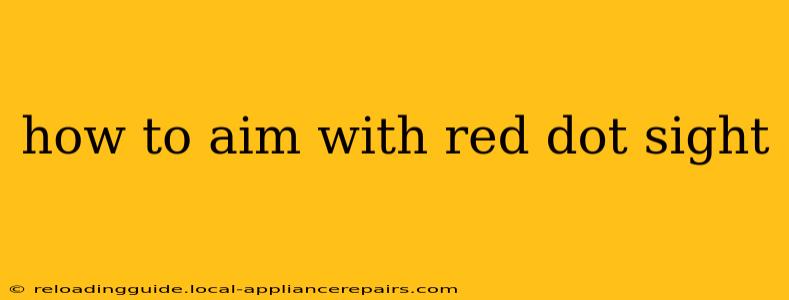Red dot sights have revolutionized aiming, offering a fast, intuitive system ideal for various shooting disciplines. Whether you're a seasoned marksman or a newcomer to firearms, understanding how to properly use a red dot sight is crucial for accuracy and consistent performance. This guide breaks down the fundamentals, covering everything from basic setup to advanced techniques.
Understanding Your Red Dot Sight
Before delving into aiming techniques, familiarize yourself with your specific red dot sight. While most operate similarly, variations exist in features like:
- Reticle type: The most common is a simple dot, but some offer circles, multiple dots, or chevron reticles. Understanding your reticle's characteristics is vital for accurate shot placement.
- Brightness settings: Adjust the brightness to match ambient lighting conditions. Too dim, and you'll struggle to see the dot; too bright, and it can wash out your target.
- Parallax: Some red dot sights are parallax-free, meaning the point of impact remains consistent even if your eye is not perfectly aligned with the optic. Others may exhibit some parallax, requiring precise eye placement. Check your sight's specifications.
- Zeroing: Before using your red dot sight, it's essential to zero it to your specific firearm and ammunition. This involves adjusting the sight's windage and elevation knobs until the point of impact matches the point of aim at various distances.
Fundamental Aiming Techniques
Mastering red dot aiming involves a combination of proper sight picture, body positioning, and trigger control.
1. Establishing the Proper Sight Picture
The core of accurate red dot aiming lies in achieving a clear and consistent sight picture. This involves:
- Eye relief: Position your eye correctly relative to the red dot sight. Too close, and you might see a distorted image. Too far, and you may lose sight of the dot entirely. Experiment to find the optimal distance.
- Dot placement: Aim to center the red dot on your target. Don't focus intently on the dot itself; instead, focus on the target, allowing your peripheral vision to perceive the dot's position. This is often called "finding your dot".
- Consistent cheek weld: Maintain a consistent cheek weld (the position of your cheek against the stock) to ensure repeatable eye relief and sight picture.
2. Body Position and Grip
Maintaining a stable platform is crucial for accuracy. Here are some key considerations:
- Stance: Adopt a stable shooting stance, ensuring your body is balanced and your weight is evenly distributed.
- Grip: Maintain a firm but relaxed grip on the firearm. Avoid squeezing the trigger until ready to fire.
- Breathing: Control your breathing. Take a breath, exhale halfway, and hold your breath while aiming and firing.
3. Trigger Control
Smooth and consistent trigger pull is essential for minimizing recoil effects and maintaining accuracy:
- Slow, deliberate pull: Avoid jerking the trigger. Instead, apply steady pressure until the firearm discharges.
- Follow-through: Maintain your aim and body position even after firing the shot.
Advanced Techniques and Considerations
As you become more proficient, explore these advanced techniques:
- Transitioning between targets: Practice quickly and accurately switching your aim between different targets.
- Moving targets: Learn how to lead moving targets, anticipating their movement to ensure accurate hits.
- Different shooting positions: Master aiming while using different positions, such as kneeling, prone, and sitting.
- Understanding your firearm's limitations: Understand the ballistic characteristics of your ammunition and how they impact your point of impact at various ranges.
Practice Makes Perfect
Mastering red dot aiming requires consistent practice. Start with close-range targets and gradually increase the distance as your proficiency improves. Regular dry firing (practicing without live ammunition) can also help refine your technique and build muscle memory. Remember, safety should always be your top priority while handling firearms. Always follow all relevant safety rules and regulations.

